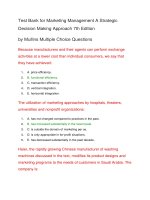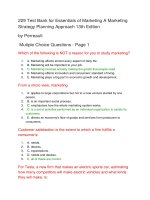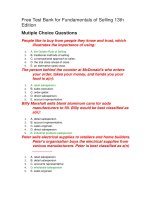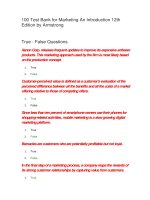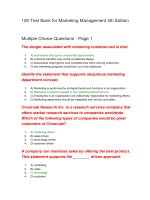396 basic marketing a strategic marketing planning approach 19th edition đề trắc nghiệm marketing
Bạn đang xem bản rút gọn của tài liệu. Xem và tải ngay bản đầy đủ của tài liệu tại đây (434.94 KB, 96 trang )
396 Basic Marketing A Strategic Marketing Planning
Approach 19th Edition
Mutiple Choice Questions - Page 1
Micro-marketing:
1.
A. tries to accomplish a company's objectives by anticipating customers' needs
and trying to satisfy them.
2.
B. begins with the production process.
3.
C. involves persuading customers to buy your product.
4.
D. is a social process involving all producers, intermediaries, and consumers.
5.
E. tries to make the whole economic system fair and effective.
Marketing
1.
A. affects almost every aspect of our daily lives.
2.
B. offers few exciting or rewarding career opportunities.
3.
C. limits our choices of goods and services every day.
4.
D. focuses an organization on being the first to market a new product.
Marketing
1.
A. means "selling" or "advertising."
2.
B. provides direction for production.
3.
C. involves actually making goods or performing services.
4.
D. does not impact consumers' standard of living.
5.
E. is the development and spread new ideas, goods, and services.
Marketing:
1.
A. emphasizes mass selling over personal selling.
2.
B. allows production, rather than marketing, to determine what products to make.
3.
C. applies to both profit and nonprofit organizations.
4.
D. concentrates on production, rather than advertising.
5.
E. None of these is a true statement about marketing.
For Tesla, a new firm that makes an electric sports car, estimating how
many competitors will make electric vehicles and what kinds they will
make, is:
1.
A. one of the universal functions of innovation.
2.
B. a production activity.
3.
C. an example of the micro-macro dilemma.
4.
D. best left to intermediaries.
5.
E. a part of marketing.
Which of the following statements best describes the modern view of
marketing?
1.
A. Marketing is only necessary for profit-oriented firms.
2.
B. Marketing consists mainly of advertising and personal selling.
3.
C. Marketing anticipates customer needs.
4.
D. Marketing begins as soon as products are produced.
5.
E. Firms that don't rely on e-commerce should put more emphasis on marketing.
In an advanced economy, marketing costs account for about ___ cents of
every consumer dollar.
1.
A. 10
2.
B. 20
3.
C. 30
4.
D. 40
5.
E. 50
A marketing manager planning to launch a successful new product should
begin by:
1.
A. obtaining financing for the venture.
2.
B. designing products that interest him or her.
3.
C.identifying a product or service that customers need.
4.
D. choosing a business partner.
5.
E. establishing a legal corporation.
Macro-marketing examines all the following challenging scenarios except:
1.
A. Producers prefer to manufacture goods in large quantities, but consumers buy
in small quantities.
2.
B. Consumers require a wide assortment of food items, but individual producers
can offer only a narrow assortment of food products.
3.
C. Producers set prices to cover costs and make a profit, but consumers choose
goods based on their ability to pay.
4.
D. Cedar Point Amusement Park would like to attract customers all year long, but
its marketing strategy is currently limited to discount season pass offers during
winter months while the park is closed.
5.
E. Producers tend to locate where it is economical to produce, but consumers are
located in many scattered places.
The following activities are rightly considered marketing except:
1.
A. advertising the grand opening of a new furniture store.
2.
B. researching which furniture designs are popular with consumers.
3.
C. determining how many pieces of furniture can be sold at different price points.
4.
D.building a facility to make furniture.
5.
E. selling furniture to customers in a furniture showroom.
Which of the following would not engage in the process of marketing?
1.
A. The United Way
2.
B. United States Postal Service
3.
C. Outback Steakhouse
4.
D. JFK International Airport
5.
E. Sam's Club members
From a micro view, which of the following is the best example of
marketing?
1.
A. North Korea unveils a new five-year production plan.
2.
B. China and the U.S. agree on a new trade agreement.
3.
C. The American Red Cross seeks more blood donors.
4.
D. The Internet makes it possible for firms to reach customers in other countries.
5.
E. None of these is a good example.
According to the text, marketing means:
1.
A.much more than selling and advertising.
2.
B. selling.
3.
C. producing and selling.
4.
D. advertising.
5.
E. selling and advertising.
Marketing should
1.
A. begin with the production process.
2.
B. make decisions about product design and packaging, prices or fees.
3.
C. not need to coordinate with production, accounting, and financial activities.
4.
D. provide input, but let production determine what goods and services are to be
developed.
5.
E. focus on getting customers to make a final purchase.
The aim of marketing is to
1.
A. help create a pure subsistence economy.
2.
B. eliminate the need for exchanges.
3.
C. persuade customers to buy the firm's product.
4.
5.
D. identify customers' needs and meet those needs so well that the product almost
"sells itself."
E. facilitate a single transaction.
Marketing can be viewed as:
1.
A. a set of activities performed by individual organizations.
2.
B. relevant to for-profit organizations only.
3.
C. just selling and advertising.
4.
D. beginning with the production process.
Marketing
1.
A. applies to both profit and nonprofit organizations.
2.
B. is another name for selling and advertising.
3.
C. should pick up where the production process ends.
4.
D. people should expect that the production department will determine what goods
and services are to be developed.
Which of the following statements best describes the modern view of
marketing?
1.
A. The job of marketing is to get rid of whatever the company is producing.
2.
B. Marketing should take over production, accounting, and financial services within
a firm.
3.
C. Marketing is concerned with generating a single exchange between a firm and
a customer.
4.
5.
D. Marketing begins with anticipating potential customer needs.
E. Production, not marketing, should determine what goods and services are to be
developed.
Predicting what types of bicycles different customers will want and
deciding which of these customers the business will try to satisfy are
activities a firm should do as part of
1.
A. production.
2.
B. a command economy.
3.
C. marketing.
4.
D. making goods or performing services.
5.
E. a production orientation.
Which of the following is NOT a reason for you to study marketing?
1.
A. Marketing affects almost every aspect of daily life.
2.
B. Marketing will be important to your job.
3.
C. Marketing involves actually making the goods that people need.
4.
D. Marketing affects innovation and consumers' standard of living.
5.
E. Marketing plays a big part in economic growth and development.
Customer satisfaction is the extent to which a firm fulfills a consumer's:
1.
A. needs.
2.
B. desires.
3.
C. expectations.
4.
D. needs and desires.
5.
E. All of these are correct.
According to the text, marketing means:
1.
A. Distribution.
2.
B. Making good products.
3.
C. More than selling and advertising.
4.
D. Promotion.
5.
E. Performing services.
_______ is defined as the performance of activities that seek to
accomplish an organization's objectives by anticipating customer needs
and directing a flow of need-satisfying goods and services from producer
to customer.
1.
A. Innovation
2.
B. Advertising
3.
C. Selling
4.
D. Marketing (from a micro view)
5.
E. Sales promotion
From a micro view, marketing
1.
A. applies to large corporations but not to a new venture started by one person.
2.
B. is an important social process.
3.
C. emphasizes how the whole marketing system works.
4.
5.
D. is a set of activities performed by an individual organization to satisfy its
customers.
E. directs an economy's flow of goods and services from producers to consumers.
Looking at marketing as a set of activities focuses on
1.
A. macro-marketing.
2.
B. for-profit marketing.
3.
C. micro-marketing.
4.
D. nonprofit marketing.
5.
E. personalized marketing.
Marketing encourages research and ______________, the development
and spread of new ideas, goods and services.
1.
A. analysis
2.
B. assessment
3.
C. evaluation
4.
D. innovation
5.
E. introspection
According to the text, marketing means:
1.
A. much more than just selling and advertising.
2.
B. advertising.
3.
C. producing a product that fills a need.
4.
D. selling.
5.
E. making a good product that sells itself.
The production of a new mountain bike model includes which of the
following activities?
1.
A. Determining how to get the new model to likely bike purchasers.
2.
B. Actually making the new mountain bikes.
3.
C. Estimating how many competing companies will be making bikes.
4.
D. Predicting what types of bikes different types of bike riders will want.
According to the text, marketing means:
1.
A. making a good product that sells itself.
2.
B. much more than selling and advertising.
3.
C. selling and advertising.
4.
D. producing goods and/or services.
5.
E. doing whatever it takes to be able to offer consumers a "better mousetrap."
Effective marketing should begin with
1.
A. an effort to persuade unwilling customers to buy the firm's products.
2.
B. potential customer needs.
3.
C. a decision about what the firm can produce efficiently.
4.
D. evaluation of the effect of the firm's decisions on the MACRO-marketing
system.
5.
E. the marketing manager making important production, accounting, and financial
decisions for the firm.
The text stresses that:
1.
2.
A. advertising and selling are not really part of marketing.
B. marketing is nothing more than a set of business activities performed by
individual firms.
3.
C. marketing techniques have no application for nonprofit organizations.
4.
D. marketing is a social process and a set of activities performed by organizations.
5.
E. a good product usually sells itself.
Which of the following statements about marketing is FALSE?
1.
A. Marketing concepts and techniques apply for nonprofit organizations—as well
as for profit-seeking organizations.
2.
B. Marketing offers many rewarding career opportunities.
3.
C. The cost of marketing is about 15 percent of the consumer's dollar.
4.
D. Marketing affects almost every part of your daily life.
5.
E. Marketing is vital for economic growth and development.
The development and spread of new ideas, goods, and services for the
marketplace is called:
1.
A. marketing.
2.
B. the micro-macro dilemma.
3.
C. collaboration.
4.
D. innovation.
5.
E. production.
Which of the following organizations would be least likely to need
marketing skills?
1.
A. An accountant
2.
B. An electronics retailer
3.
C. A toy manufacturer
4.
D. A financial advisor
5.
E. All of these organizations would be likely to need marketing skills.
____________________ is the extent to which a firm fulfills a customer's
needs, desires, and expectations.
1.
A. Customer forecast
2.
B. Customer satisfaction
3.
C. Customer service
4.
D. Customer support
Which of the following statements by a U.S. president best reflects a
MICRO view of marketing?
1.
A. "A tax cut will give consumers more spending money."
2.
B. "With interest rates low, many young people can now afford to buy a new
home."
3.
C. "In the United States we have a better choice of products than in any other
country."
4.
D. "My administration will spend 75 percent more on purchases related to
domestic security during the next year."
5.
E. "Tourism firms should advertise more to attract more international visitors."
Micro-marketing:
1.
A. is concerned with whether the whole economic system is fair and effective.
2.
B. applies only to profit organizations.
3.
C. consists only of personal selling and advertising.
4.
D. is a social process only.
5.
E. tries to anticipate and satisfy customer needs and accomplish an organization's
objectives.
All of the following should be determined by the marketing department of
a firm EXCEPT:
1.
A. storing the product.
2.
B. actually making the product.
3.
C. advertising the product.
4.
D. designing the packaging for the product.
5.
E. setting the price of the product.
Marketing:
1.
2.
A. applies to both profit and nonprofit organizations.
B. says that marketing should take over all production, accounting, and financial
activities.
3.
C. should begin as soon as goods are produced.
4.
D. does away with the need for advertising.
250 Free Test Bank for Basic Marketing A Strategic
Marketing Planning Approach 19th Edition by Perreault
Mutiple Choice Questions - Page 2
Of the following headlines from the WALL STREET JOURNAL, which is
most likely to be about a MACRO-marketing topic?
1.
A. "Tupperware Has a New Strategy."
2.
B. "Thailand Has Unusually Large Number of Wholesalers."
3.
C. "Military Supplier Shifts to Selling Gas Masks to Private Citizens."
4.
D. "Coke Plans Beverage Line to Compete with Lipton's."
5.
E. "Dow Chemical Adds Shipping Safeguards."
Macro-marketing:
1.
A. Emphasizes how the whole marketing system works.
2.
B. Considers how marketing affects society, but not how society affects marketing.
3.
C. Matches homogeneous supply and demand.
4.
D. Is mainly concerned with the activities of individual organizations.
Which of the following must occur for marketing to happen?
1.
A. Product
2.
B. Place
3.
C. Advertising
4.
D. Price
5.
E. Two or more parties exchange something of value for something else of value.
In advanced economies:
1.
A. mass production with its economies of scale makes the cost of each product
higher.
2.
B. exchange is simplified by discrepancies of quantity and assortment.
3.
C. there is little need for marketing specialists.
4.
D. both supply and demand tend to be homogeneous in nature.
5.
E. producers and consumers experience a separation of values.
Of the following headlines from a business magazine, which is most likely
to be about a macro-marketing topic?
1.
A. "Chinese Women Demand More Luxury Goods."
2.
B. "Girl Scouts Organize Nationwide Cookie Sale."
3.
C. "L'eggs Sells Direct in Brazil and Argentina."
4.
D. "Frito-Lay Offers New Low-Fat Products."
5.
E. "Coke Losing Beverage Sales in India to local brands."
When a firm produces a large quantity of a product, the cost of producing
each individual unit usually goes down. This is known as:
1.
A. discrepancies of quantity.
2.
B. exchange efficiency.
3.
C. economies of scale.
4.
D. macro-marketing.
5.
E. discrepancies of assortment.
Macro-marketing:
1.
2.
A. is a social process.
B. tries to encourage "discrepancies of quantity" and "discrepancies of
assortment."
3.
C. tries to disrupt supply and demand.
4.
D. tries to foster the many separations between producers and consumers.
_________ directs an economy's flow of goods and services from
producers to consumers in a way that effectively matches supply and
demand and accomplishes the society's objectives.
1.
A. Macro-marketing
2.
B. The transporting function
3.
C. Micro-marketing
4.
D. Standardization and grading
5.
E. Social responsibility
Viewing marketing as a social process focuses on
1.
A. marketing by nonprofit organizations.
2.
B. command economies.
3.
C. macro-marketing.
4.
D. micro-marketing.
5.
E. None of these is correct.
Macro-marketing:
1.
A. is concerned with the activities performed by individual business organizations.
2.
B. tries to match heterogeneous supply capabilities with heterogeneous demands
for goods and services.
3.
C. is concerned with how effectively and fairly an individual business organization
performs.
4.
D. assumes that the effectiveness and fairness of all macro-marketing systems
must be evaluated in terms of the same social objectives.
Marketing could NOT take place without:
1.
A. intermediaries.
2.
B. collaborators.
3.
C. two or more parties who are willing to exchange something for something else.
4.
D. a high standard of living.
Since individual firms cannot perform all marketing functions, _____ often
play a role in the exchange process.
1.
A. intermediaries
2.
B. consumers
3.
C. nonprofits
4.
D. marketing managers
5.
E. government regulators
_______ refers to producers holding title to goods and services that they
themselves do not want to consume and consumers wanting goods and
services that they do not have.
1.
A. Discrepancies of assortment
2.
B. Separation of ownership
3.
C. Discrepancies of quantity
4.
D. Spatial separation
5.
E. Separation in time
In a simple economy, one family may produce only cooking pots, but
many of them. Others may specialize in farming, making clothing, and
building shelters. This
1.
A. shows why "discrepancies of assortment" occur.
2.
B. is so simple that the universal functions of marketing don't have to be done.
3.
C. cannot work without an intermediary.
4.
D. is an example of "separation in values" since the different families choose to
produce different things.
Marketing is NOT needed in a ______________ economy.
1.
A. consumer-oriented
2.
B. command
3.
C. pure subsistence
4.
D. market-directed
5.
E. None of these is correct.
"Economies of scale" means that:
1.
A. as a company produces larger numbers of a particular product, the cost of each
unit of the product goes down.
2.
B. the more producers there are in an economy the greater the need for
intermediaries.
3.
4.
C. larger countries enjoy more economic growth than smaller countries.
D. as a company produces larger numbers of a particular product, the total cost of
producing these products goes down.
Discrepancies of assortment happen when
1.
A. producers prefer to produce and sell in large numbers, but consumers prefer to
buy and consume in smaller numbers.
2.
B. consumers may not want to consume goods and services at the time producers
would prefer to produce them.
3.
C. consumers value goods and services in terms of costs and competitive prices
whereas producers value them in terms of satisfying needs and ability to pay.
4.
D. producers specialize in producing a narrow range of goods and services but
consumers need a wide variety.
5.
E. producers hold title to goods and services that they themselves do not want to
consume.
The fact that US car companies are located in the upper Midwest while
their customers are located throughout the U.S. is an example of:
1.
A. separation in values.
2.
B. discrepancies of assortment.
3.
C. separation of information.
4.
D. spatial separation.
5.
E. separation in time.
Which of the following statements about marketing is FALSE?
1.
A. Marketing affects the products you buy.
2.
B. Marketing applies to nonprofit organizations too.
3.
C. Marketing affects the advertising you see and hear.
4.
D. Marketing offers many good job opportunities.
5.
E. Marketing can help with individual transactions but not in building relationships
with customers.
From the macro-marketing perspective, the spatial separation that exists
between military equipment manufacturers and the people who use the
equipment overseas is directly addressed through this marketing
function:
1.
A. financing
2.
B. transporting
3.
C. risk taking
4.
D. market information
5.
E. storing
If the family units on a South Pacific-island nation made all the products
they consume, it would be a good example of:
1.
A. a pure subsistence economy.
2.
B. a market-directed economy.
3.
C. a micro-marketing system.
4.
D. a command economy.
5.
E. None of these is a correct answer.
American supermarket chain, FoodMart, purchases cheese from five
different manufacturers from around the world to assure its customers
can choose among different types of cheeses at different prices. FoodMart
facilitates the macro-marketing system by helping to address:
1.
A. spatial separation.
2.
B. discrepancies of assortment.
3.
C. separation of values.
4.
D. all of these are correct.
Exchanges between producers and consumers are more difficult in an
advanced economy because of:
1.
A. separation in time.
2.
B. separation in values.
3.
C. spatial separation.
4.
D. separation of information.
5.
E. All of these are correct.
When an individual producer sets a price for its product to earn a certain
profit while consumers search for the product at the lowest price available
from any producer, this is an example of:
1.
A. separation in time.
2.
B. discrepancy of quantity.
3.
C. separation in values.
4.
D. discrepancy of assortment.
5.
E. spatial separation.
The term "economies of scale" means that:
1.
A. The largest producers are always the most efficient.
2.
B. The cost of a product goes down as a company produces larger numbers of it.
3.
C. The more one produces, the greater the profit.
4.
D. It is more efficient for an economy to have a large number of transactions.
5.
E. None of these is correct.
In advanced economies:
1.
A. both supply and demand tend to be homogeneous.
2.
B. producers and consumers are often separated in several ways.
3.
4.
C. most firms specialize in producing and selling small amounts of a huge
assortment of goods and services.
D. exchange is aided by discrepancies of quantity and assortment.
The following headlines are for articles from the WALL STREET
JOURNAL. Which article is most likely to be reporting a macro-marketing
topic?
1.
A. "Mercedes Goes after Luxury Sport Utility Buyers."
2.
B. "Adidas Jumps as Footwear Competition Heats Up."
3.
C. "Drugstore Chain Aims at Seniors."
4.
D. "Hardee's Fried Chicken Takes on KFC."
5.
E. "DVD Popularity Leads to More DVD Retailers."
Looking at marketing as a social process focuses on
1.
A. macro-marketing.
2.
B. for-profit marketing.
3.
C. micro-marketing.
4.
D. nonprofit marketing.
5.
E. personalized marketing.
Macro-marketing
1.
A. emphasizes building a long-term relationship that benefits both the firm and the
customer.
2.
B. considers the marketing activities of corporations rather than individuals.
3.
C. emphasizes how the whole marketing system works.
4.
D. systems are only relevant to advanced economies.
5.
E. addresses discrepancies that emerge from homogeneous consumer demand.
In a pure subsistence economy,
1.
A. each family unit is self-sufficient.
2.
B. exchanges are very important.
3.
C. the standard of living must be relatively high.
4.
D. there is a great need for intermediaries.
Marketing will not happen unless:
1.
A. e-commerce is flourishing.
2.
B. collaborators are present to simplify exchange.
3.
C. intermediaries are present to facilitate exchange.
4.
5.
D. two or more parties each have something they want to exchange for something
else.
E. an economy is market-directed rather than command.
Macro-marketing
1.
A. is a social process.
2.
B. concerns the activities of individual managers.
3.
C. is what people have in mind when they talk about marketing in everyday use.
4.
D. helps consumers that need a narrow assortment of products.
5.
E. applies only to nonprofit organizations.
Societies need a macro-marketing system
1.
A. to help match supply and demand.
2.
B. to create a gap between producers and consumers.
3.
C. to accomplish an organization's objectives only.
4.
D. to identify collaborators.
5.
E. to reduce the need for intermediaries.
When consumers do not know where to buy a product or what it costs and
the product's producer does not know where its target market is located,
this is an example of:
1.
A. separation of information.
2.
B. discrepancy of quantity.
3.
C. separation of ownership.
4.
D. discrepancy of assortment.
5.
E. separation in time.
The following headlines are from Business Week magazine. Which article
is most likely to be reporting on a macro-marketing topic?
1.
A. "Two-Person Engineering Firm Offers Unique Service."
2.
B. "Russia Increases Output of Consumer Goods."
3.
C. "Pepsi Sells in Japan."
4.
D. "Bank of America Offers New Internet Banking Services."
5.
E. "Donations to Tsunami Victims Fund Increase after TV Broadcast."
The fact that producers usually prefer to produce products in large
quantities, while most consumers prefer to buy in small quantities, results
in:
1.
A. discrepancies of quantity.
2.
B. separation of ownership.
3.
C. discrepancies of assortment.
4.
D. spatial separation.
5.
E. temporal separation.
Which of the following statements is FALSE?
1.
A. Marketing is most important in a pure subsistence economy.
2.
3.
4.
5.
B. Marketing should provide direction for production, accounting, and financial
activities.
C. Marketing builds long-lasting relationships that benefit the selling firm.
D. Marketing doesn't occur unless two or more parties are willing to exchange
something for something else.
E. Marketing anticipates customer needs.
Macro-marketing:
1.
A. tries to produce discrepancies of quantity and discrepancies of assortment.
2.
B. focuses on the activities of individual organizations.
3.
C. tries to effectively match supply and demand.
4.
D. is a set of activities performed by individual firms.
The primary purpose of the transporting and storing functions of
marketing is to overcome:
1.
A. the need for marketing specialists.
2.
B. separation of information.
3.
C. spatial separation.
4.
D. discrepancies of assortment.
5.
E. separation of values.
The universal functions of marketing include buying, selling, transporting,
storing, _________________________________________.
1.
A. standardization and weighing, financing, risk taking, and marketing information
2.
B. standardization and grading, facilitating, risk taking, and marketing information
3.
C. standardization and grading, financing, risk taking, and marketing information
4.
D. standardization and grading, financing, risk taking, and merchandising
information
250 Free Test Bank for Basic Marketing A Strategic
Marketing Planning Approach 19th Edition by Perreault
Mutiple Choice Questions - Page 3
Concerning the "universal functions of marketing," which of the following
statements is false?
1.
A. These functions can be performed by producers, intermediaries, collaborators,
or consumers.
2.
B. Responsibility for performing these functions can be shared and shifted.
3.
C. From a micro viewpoint, not every company must perform every function.
4.
D. From a macro viewpoint, all these functions must be performed by someone.
5.
E. None of these statements is false.
From the perspective of macro-marketing, e-commerce specialists CarFax
(which provides vehicle history reports) and Cars.com (a website offering
auto comparison shopping) have emerged within the auto industry
because:
1.
A. auto manufacturers need to sell direct to consumers.
2.
B. the market needs competitive rivals to auto dealerships.
3.
C. the information they provide makes the exchange process between producers
and consumers more efficient and effective.
4.
D. the role of the automotive sales person is becoming obsolete.
5.
E. consumers live far distances from most automotive plants
Which of the following is NOT one of the "universal functions of
marketing"?
1.
A. Production
2.
B. Standardization
3.
C. Financing
4.
D. Buying
5.
E. Transporting
The advantages of working with an intermediary usually increase when
there is
1.
A. excellent communication with customers.
2.
B. a greater number of customers.
3.
C. little distance between customers.
4.
D. a smaller number of competing products.
Amazon.com and eBay.com are both considered
1.
A. Internet-based collaborators.
2.
B. Internet-based producers.
3.
C. Internet-based service providers.
4.
D. Internet-based intermediaries.
5.
E. Internet-based manufacturers.
Which of the following is LEAST likely to be classified as a marketing
collaborator?
1.
A. Mayflower Transport Company.
2.
B. Internet Advertising, Inc.
3.
C. Wachovia Bank.
4.
D. Market Survey Research, Inc.
5.
E. Quality Coatings and Paint Company.
______________ involve(s) sorting products according to size and quality.
1.
A. Transporting and storing
2.
B. Financing
3.
C. Standardization and grading
4.
D. Marketing
5.
E. Buying
An economic system in which government officials determine production
levels is known as:
1.
A. pure subsistence.
2.
B. macro-marketing.
3.
C. market-directed.
4.
D. production-oriented.
5.
E. command.
The "universal functions of marketing":
1.
A. must be performed in all MACRO-marketing systems.
2.
B. are performed the same way in all economies.
3.
C. are performed by the same parties in all economies.
4.
D. are needed to help foster various separations and discrepancies.
The "universal functions of marketing" do NOT include:
1.
A. financing and risk taking.
2.
B. standardization and grading.
3.
C. producing.
4.
D. transporting and storing.
5.
E. buying and selling.
The standardization and grading function of marketing involves:
1.
A. Looking for and evaluating goods and services.
2.
B. Providing necessary cash and credit.
3.
C. Promoting the product.
4.
D. Sorting products according to size and quality.

